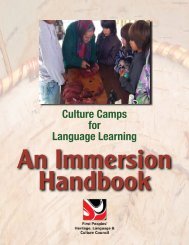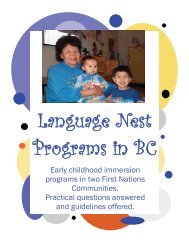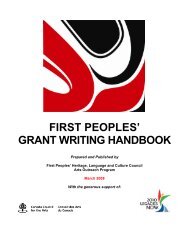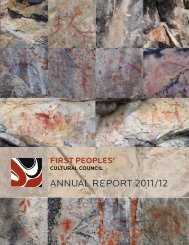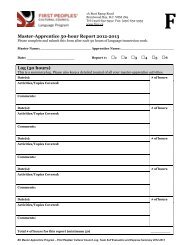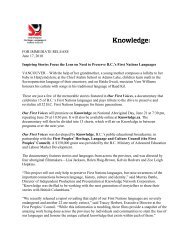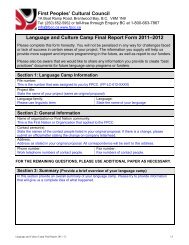What is the status of BC First nations languages? - First Peoples
What is the status of BC First nations languages? - First Peoples
What is the status of BC First nations languages? - First Peoples
Create successful ePaper yourself
Turn your PDF publications into a flip-book with our unique Google optimized e-Paper software.
Table 1: <strong>First</strong> <strong>Peoples</strong>’ Council Framework for Defining and Measuring Language Endangerment *Level <strong>of</strong> Endangerment Speakers Usage Language ResourcesThrivingRobust• Many speakers <strong>of</strong> all ages• Children use <strong>the</strong> language in all situations• Number <strong>of</strong> speakers increases with increasedbirth rate and increased population• Language normally learned as mo<strong>the</strong>r tongue• Intergenerational language transm<strong>is</strong>sion• Language naturally used in a large number <strong>of</strong>domains i.e. home, work, school, community,government, social• Officially recognized as <strong>the</strong> language <strong>of</strong> use• Media (print, audio and v<strong>is</strong>ual), governmentdocuments, literature, formal and informalcommunication in <strong>the</strong> language• Materials and documents increasingly producedin <strong>the</strong> languageSafe• Many speakers <strong>of</strong> all ages• Number <strong>of</strong> speakers increases with increasedbirth rate and increased population.• Language learned at home by a steady number<strong>of</strong> children• Intergenerational language transm<strong>is</strong>sion• Language naturally used in a number <strong>of</strong>domains i.e. home, work, school, community,government, social, but <strong>is</strong> not <strong>the</strong> dominantlanguage• Officially recognized as a language <strong>of</strong> use• Some <strong>of</strong> <strong>the</strong> following produced in <strong>the</strong>language: media (print, audio and v<strong>is</strong>ual),government documents, literature, formal andinformal communication• Some materials and documents produced in<strong>the</strong> languageDecliningUnstable• Spoken as mo<strong>the</strong>r tongue by a small anddecreasing number <strong>of</strong> children• Spoken by a fairly large number <strong>of</strong> adults andelders• Not spoken between generations as <strong>the</strong> norm• Used in some homes• Use in schools and community <strong>is</strong> a concertedeffort• May be <strong>of</strong>ficially recognized, i.e. by localgovernment• Documentation i.e. recordings and writtenrecords increasing somewhat• Possible creation <strong>of</strong> many learning materialsand resourcesEndangered• Spoken as a mo<strong>the</strong>r tongue only by a smallnumber <strong>of</strong> <strong>the</strong> parent-aged generation and up• Spoken somewhat by a small and decreasingnumber <strong>of</strong> adults and children• Used somewhat in homes• Use in schools and community <strong>is</strong> aconcerted effort• Limited language programming in schools• Used mostly during <strong>the</strong> learning process,not in natural communication• Some documentation i.e. recordingsand written records• Increasing documentation <strong>is</strong> possible• Efforts to create more learning materials andresourcesCriticallyEndangeredSeverelyEndangered• Very rarely/never learned as mo<strong>the</strong>r tongueby children• Spoken as mo<strong>the</strong>r tongue by grandparentgeneration and up• Not normally spoken by adults and childrenexcept for some who are learning• Only sometimes used between elderly speakers• Rarely/never used for natural dailycommunication• Some adults and children learning, but notfluent• Limited language learning programs• Limited documentation i.e. some recordingsand written records <strong>of</strong> variable quality• Some <strong>languages</strong> have extensive documentation,but few to no speakersNearlyExtinct• No longer being learned by adults or childrenas <strong>the</strong> norm• Only spoken by very few <strong>of</strong> <strong>the</strong> grandparent-agedgeneration• Finite number <strong>of</strong> elderly speakers• Rarely used by elders except for documentationpurposes• Some language programming may ex<strong>is</strong>t i.e.classes, immersion, documentation etc.• Some documentation (usually limited)• Challenging to check for accuracy or to increasedocumentationExtinct Sleeping • No living speakers • Not used• Some language programming may ex<strong>is</strong>ti.e. reconstructing <strong>the</strong> language from olddocumentation• Some documentation (usually limited)• No way to check for accuracy or to increasedocumentation <strong>of</strong> mo<strong>the</strong>r-tongue speakers* A language can <strong>of</strong>ten fall into more than one level <strong>of</strong> endangerment.For one variable a language may seem to fall into a certain level <strong>of</strong> endangerment,but for ano<strong>the</strong>r variable it may fall into a different level <strong>of</strong> endangerment.<strong>First</strong> <strong>Peoples</strong>’ Heritage, Language and Culture Council 13





